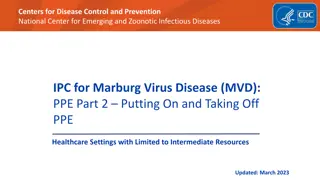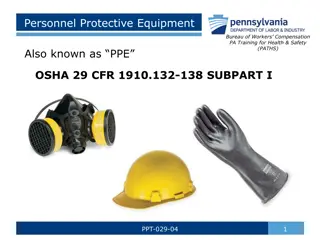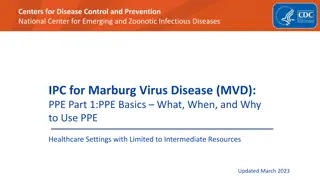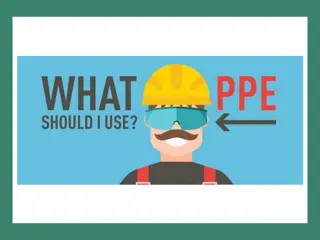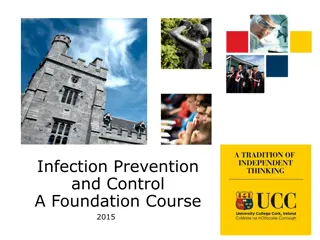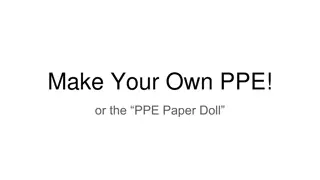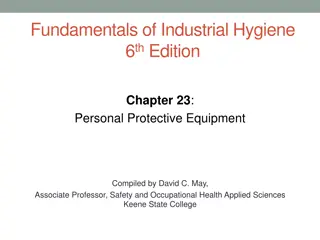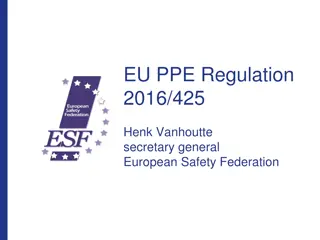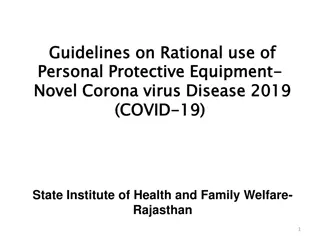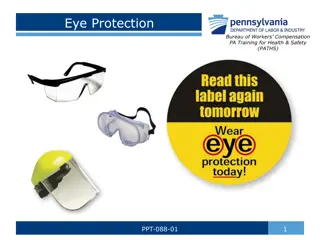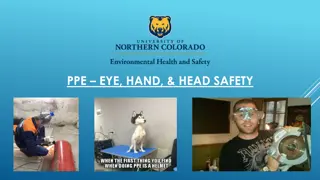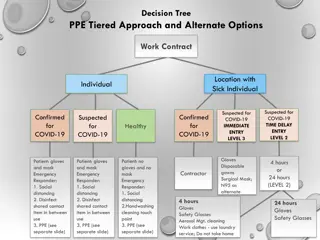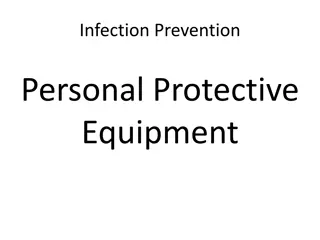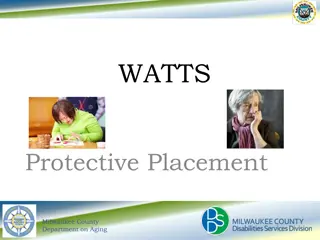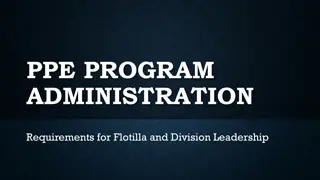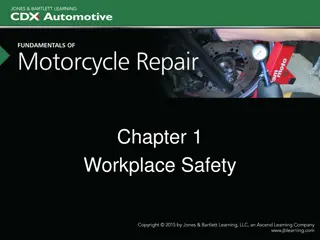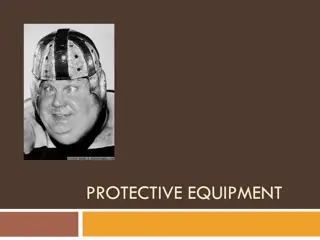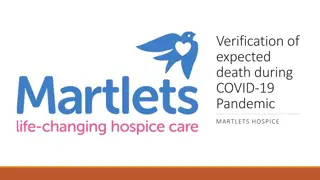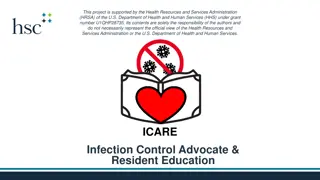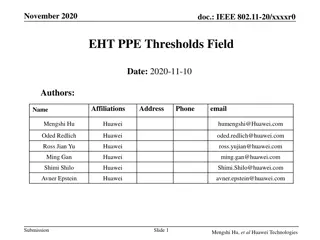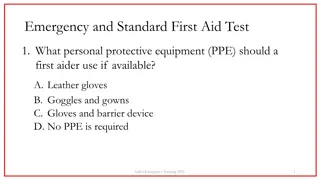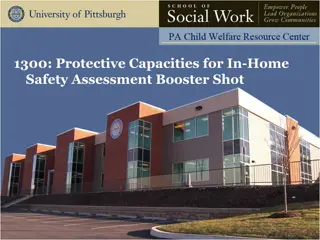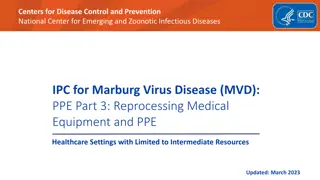Comprehensive Guide on Donning and Doffing Personal Protective Equipment (PPE) in the Workplace
This comprehensive guide covers the importance of donning and doffing PPE as part of an employer's safety program, including exposure control plans and procedures. It emphasizes the correct use of basic personal protective equipment and provides information on legislative responsibilities, appropriate hand hygiene, training requirements, and safety regulations. The content also includes images and practical demonstrations to enhance understanding and compliance with occupational health and safety standards.
Download Presentation

Please find below an Image/Link to download the presentation.
The content on the website is provided AS IS for your information and personal use only. It may not be sold, licensed, or shared on other websites without obtaining consent from the author. Download presentation by click this link. If you encounter any issues during the download, it is possible that the publisher has removed the file from their server.
E N D
Presentation Transcript
Donning & Doffing Personal Protective Equipment (PPE) One part of an employer s comprehensive safety program with a focus on an exposure control plan and procedures when using basic personal protective equipment May 2021
HousekeepingDetails http://www.diyderby.co.uk/ekmps/shops/bartlam/images/emergency-exit-sign-300-x-200-code-1516-1024-p.jpg
Welcome & Introduction Welcome to Donning & Doffing Personal Protective Equipment Successful completion of this program includes: active involvement in discussion return demonstration of donning and doffing techniques with appropriate hand hygiene Evaluation pre session
What You Will Learn The employer legislated responsibilities for personal protective equipment and education/training Legislated responsibilities and rights as a worker Legislated requirements for personal protective equipment Appropriate donning (putting on) and doffing (removing) of PPE (namely; gowns, gloves, procedure/surgical mask/respirator, goggles/face shield) and why the order is important Appropriate hand hygiene (with alcohol based hand rub and soap & water)
Legislation Saskatchewan s OH&S legislation (Saskatchewan Employment Act) states: Train means to give information and explanation to a worker with respect to a particular subject-matter and require a practical demonstration that the worker has acquired knowledge or skill related to the subject matter;
Legislation The Occupational Health and Safety Regulations, 2020, Regulation 3-1(c) states: General duties of employers (c) the provision of any information, instruction, training and supervision that is necessary to protect the health and safety of workers at work;
Legislation The Occupational Health and Safety Regulations, 2020, Regulation 3-2 states: A worker shall: (a) use the safeguards, safety appliances and personal protective equipment provided in accordance with these regulations and any other regulations made pursuant to the Act; and (b) follow the safe work practices and procedures required by or developed pursuant to these regulations and any other regulations made pursuant to the Act.
Legislation Every worker has three rights: 1. Right to Knowthe hazards at their workplace, to be trained to recognize them, and to be trained to protect themselves. 2. Right to Participatein their own safety as well as the safety program in their workplace. 3. Right to Refusean act or series of acts where the worker has reasonable grounds to believe that it is unusually dangerous. This is a refusal of an individual worker, not a group of workers.
Legislation The Occupational Health and Safety Regulations, 2020, Part 7, is all about personal protective equipment. use of PPE inspection of PPE eye and face protection use of PPE when workers are exposed to hazardous substances
Accountability What does accountability mean to you? The general definition of accountability includes: being bound to give an explanation of your conduct being responsible; answerable. How should we be held accountable?
Training, Practice, Competence, Observation Training: this is considered your training session. Ask questions. Practice: Perfect practice makes perfect. This will take time, we ll practice very slow and deliberate - this is a task that we will not rush through. Competence: this is your know how , your ability to use what you will be taught today. So know how to don and doff with appropriate hand hygiene before you leave this session. Observation: this is where I am going to watch and coach each of you don and doff every piece of PPE and perform hand hygiene.
PPE Overview The purpose of PPE is to provide protection not only for the worker but also with eliminating or managing the risk of transferring a biological hazard to a client or another individual.
Principles of PPE Donning - PPE must be donned correctly in proper order. During Patient Care - PPE must remain in place and be worn correctly for the duration of exposure to potentially contaminated areas. PPE should not be adjusted. Don t adjust your eyeglasses, hair, etc. Don t touch any part of your face. In some situations, having a buddy with you will help to check for a partial or total breach in PPE. Doffing - Can be a high-risk process that requires a structured procedure; may require a trained co-worker when using procedures; designated area for removal to ensure protection. PPE must be removed slowly and deliberately in the correct sequence to reduce the possibility of self-contamination or environmental contamination.
Remember! Always move slowly it is a step by step task Do not rush when donning PPE Have your hair tied back/out of the way Avoid touching PPE once donned Avoid touching face, exposed skin Do not rush when doffing PPE Use appropriate waste receptacle (preferably hands-free) and discard carefully
Hand Hygiene Proper hand hygiene is critical and used during the donning and doffing process. Before touching the PPE; clean your hands with alcohol based hand rub (ABHR) or soap and water - and ensure you rub/scrub each part of your hand. Removing rings/bracelets or refraining from wearing these items during work supports good infection control. When your hands are visibly dirty, always use soap and water.
Hand Hygiene Using Soap and Water may take 40-60 seconds total Step 1: Wet hands with warm water. Step 2: Apply soap. Step 3: Wash hands and ensure you rub/scrub all areas - your palms, back of each hand, between and around each finger and thumbs, tips of fingers and thumbs, cuticles and under nails. This step could take 15 seconds or more. Step 4: Rinse well. Step 5: Dry hands well with paper towel. Step 6: Turn off tap and open washroom door using paper towel. Using Alcohol Based Hand Rub (ABHR) may take 20-30 seconds total Step 1: Apply palm full of ABHR - enough to cover all surfaces of both your hands. Step 2: Rub hands and ensure you rub/scrub all areas - your palms, back of each hand, between and around each finger and thumbs, tips of fingers and thumbs, cuticles and under nails. This step could take 15 seconds or more
Safe Work Practices Use the following safe work practices to protect yourself and limit the spread of contamination: Keep your hands away from your face and limit the surfaces you touch. Change gloves when torn or heavily contaminated. Regularly perform hand hygiene. An alcohol based hand rub (ABHR) is the preferred method to clean hands. If hands look or feel soiled, use soap and water to clean hands.
Donning Sequence 1. Proper hand hygiene 2. Inspection of PPE - tears, rips, soiling - anything that is found to be soiled/damaged/defective must be removed from use, properly disposed of or labeled accordingly 3. Gown 4. Procedure/surgical mask/respirator 5. Goggles/face shield 6. Gloves 7. Inspection again. Check for gaps/tears during donning and that PPE remains intact during range of motion - moving your arms, legs and neck
Doffing Sequence 1. Gloves 2. Gown 3. Goggles/face shield 4. Procedure/surgical mask/respirator Proper hand hygiene throughout
An Approach is to Coach A Coach may be beneficial to assist workers with donning and doffing PPE. The sequence and actions involved in each donning and doffing step are critical to avoiding exposure. The coach: is a dedicated individual with the responsibility of ensuring adherence to the entire donning and doffing process will be knowledgeable about all PPE recommended in the facility s protocol and the correct donning and doffing procedures, including disposal of used PPE may read aloud to the worker each step in the procedure checklist and visually confirm that the step has been completed correctly will ensure the worker avoids touching their face/exposed skin during the donning and doffing procedure inspects PPE for gaps and adjusts if necessary conducts range of motion activities to ensure PPE stays intact and the worker is comfortable should know the exposure management plan in the event of an unintentional break in procedure
Re-evaluation Every worker trained in SASWH s Donning & Doffing PPE course should be re-evaluated at least once every 2 years. The re-evaluation would include practice and return demonstration on donning and doffing basic PPE with appropriate hand hygiene. Ongoing support, Safety Talks, using the Coach Approach would assist with maintaining skills following training. Employers are required to keep records of worker training and is to ensure that training remains current.
Summary and Infection Control Summary Specific steps are required when donning (putting on) and doffing (removing) PPE. There may be additional specific steps depending on the PPE you are using for the specific situation. Infection Control (IC) There are specific infection control precautions and procedures that healthcare workers are required to follow. Please refer to/consult the following resources for further information: 1. the approved infection control manual/policies/procedures for your agency/health region; 2. the designated agency/health region IC professional; or 3. your supervisor.
To Protect Yourself, You Can: Ask for training on PPE Use the appropriate PPE Keep yourself current on PPE Practice - perfect practice makes perfect Know your employer s current policy and procedures
Bringing It All Together PPE will be provided by the employer Staff will be trained on appropriate donning and doffing techniques that includes hand hygiene Follow guidelines in place; keep your documents handy for reference Ask for help if you need it Buddy up - have a trained worker observe you and do the same for them - coach and mentor each other
Stay Safe Completion of the evaluation form Thank You for attending . Be Aware Be Healthy Be Safe


